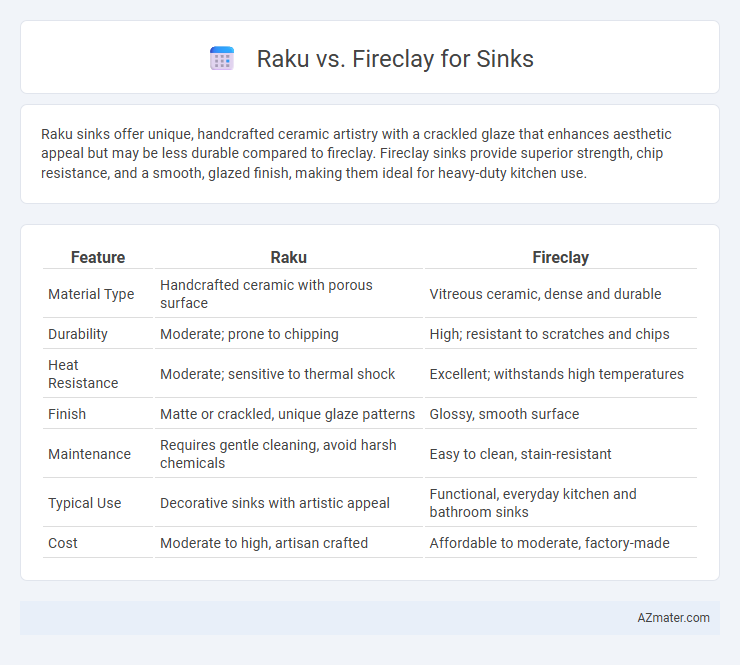Raku sinks offer unique, handcrafted ceramic artistry with a crackled glaze that enhances aesthetic appeal but may be less durable compared to fireclay. Fireclay sinks provide superior strength, chip resistance, and a smooth, glazed finish, making them ideal for heavy-duty kitchen use.
Table of Comparison
| Feature | Raku | Fireclay |
|---|---|---|
| Material Type | Handcrafted ceramic with porous surface | Vitreous ceramic, dense and durable |
| Durability | Moderate; prone to chipping | High; resistant to scratches and chips |
| Heat Resistance | Moderate; sensitive to thermal shock | Excellent; withstands high temperatures |
| Finish | Matte or crackled, unique glaze patterns | Glossy, smooth surface |
| Maintenance | Requires gentle cleaning, avoid harsh chemicals | Easy to clean, stain-resistant |
| Typical Use | Decorative sinks with artistic appeal | Functional, everyday kitchen and bathroom sinks |
| Cost | Moderate to high, artisan crafted | Affordable to moderate, factory-made |
Introduction to Raku and Fireclay Sinks
Raku sinks are handcrafted ceramic fixtures known for their unique crackled glaze and rustic aesthetic, offering a distinctive, artisanal appeal for kitchen and bathroom spaces. Fireclay sinks, made from fired clay mixed with enamel, provide exceptional durability and a smooth, glossy finish that resists stains, chips, and heat. Both materials offer timeless beauty, with Raku emphasizing artistic texture and Fireclay prioritizing strength and longevity.
Material Composition: Raku vs Fireclay
Raku sinks are crafted from clay fired at lower temperatures, resulting in a porous and more fragile finish, while fireclay sinks are made from a mixture of clay and glaze fired at extremely high temperatures, creating a dense, durable, and non-porous surface. Fireclay's vitrification process offers superior resistance to chipping, scratching, and stains compared to Raku's delicate ceramic glaze. This difference in material composition makes fireclay sinks ideal for heavy kitchen use, whereas Raku sinks are better suited for decorative or light-use applications.
Durability and Strength Comparison
Raku sinks, crafted using a specialized pottery firing process, offer moderate durability but may be more prone to chipping and cracking due to their porous nature compared to fireclay sinks. Fireclay sinks are made from a blend of clay and minerals, fired at extremely high temperatures, resulting in a denser, non-porous surface that significantly enhances strength and resistance to scratches, chips, and heat. The superior durability of fireclay makes it a preferred choice for heavy-use kitchen settings, whereas raku sinks are better suited for decorative or light-use applications.
Aesthetic Appeal and Design Flexibility
Raku sinks feature a unique, handcrafted appearance with iridescent glazes and organic textures that enhance rustic and artistic kitchen or bathroom aesthetics. Fireclay sinks offer a smooth, glossy finish in a wider range of classic and contemporary shapes with high resistance to stains and chips, providing versatile design options. Both materials support customization, but Raku emphasizes artistic uniqueness, while Fireclay prioritizes durability and clean, timeless lines.
Heat and Stain Resistance
Raku sinks are handcrafted ceramic pieces known for their artistic appeal but tend to have lower heat resistance, making them less suitable for exposure to extreme temperatures. Fireclay sinks, made from molded clay fired at high temperatures, offer superior heat resistance and can withstand hot pots and pans without cracking or discoloration. Fireclay also excels in stain resistance due to its non-porous glaze, ensuring long-lasting durability and easy maintenance in kitchen environments.
Maintenance and Cleaning Requirements
Raku sinks require gentle cleaning with mild soap and avoid abrasive materials to prevent chipping due to their porous and fragile ceramic surface. Fireclay sinks are more durable, stain-resistant, and withstand harsh cleaners, making maintenance easier with routine wiping and occasional scrubbing. Choosing Fireclay minimizes long-term upkeep compared to the delicate nature of Raku ceramic finishes.
Installation Differences
Raku sinks typically feature a lighter, thinner ceramic construction allowing for easier countertop cutouts, resulting in straightforward undermount or drop-in installations. Fireclay sinks are denser and heavier, requiring reinforced cabinetry and precise countertop support to prevent stress and ensure durability during installation. The increased weight and rigidity of fireclay mean professional installation is recommended to handle mounting clips securely and avoid damage.
Cost and Value Analysis
Raku sinks generally offer a unique, handcrafted aesthetic with moderate pricing, making them a cost-effective choice for homeowners seeking distinctive design without premium expenses. Fireclay sinks, known for their durability and resistance to chips and stains, typically come at a higher price point but provide long-term value through longevity and minimal maintenance. Evaluating cost against durability, Fireclay sinks deliver superior investment value, whereas Raku sinks serve better for budget-conscious buyers prioritizing style.
Environmental Impact and Sustainability
Raku sinks, often handcrafted from clay with high-temperature firing, use fewer chemicals and emit lower VOCs, contributing to reduced environmental impact compared to Fireclay sinks, which involve more intensive manufacturing and glazing processes that increase energy consumption. Fireclay sinks, though durable and resistant to chipping, require high firing temperatures that result in greater carbon emissions and nonrenewable resource use. Choosing Raku sinks supports sustainability goals by minimizing greenhouse gas emissions and promoting eco-friendly material sources while maintaining functional durability in kitchen and bathroom applications.
Which Sink Material Should You Choose?
When choosing between Raku and Fireclay sinks, consider durability and aesthetic appeal: Fireclay sinks are highly resistant to scratches, stains, and heat due to their ceramic composition, making them ideal for heavy kitchen use. Raku sinks, crafted through a specialized firing process, offer unique, artisanal designs but tend to be less durable and more prone to chipping. Selecting the right sink material depends on balancing Fireclay's robustness and low maintenance with Raku's distinct, handcrafted beauty.

Infographic: Raku vs Fireclay for Sink
 azmater.com
azmater.com